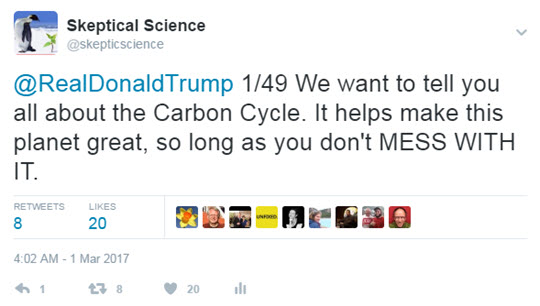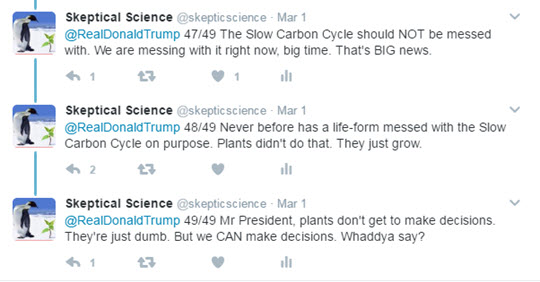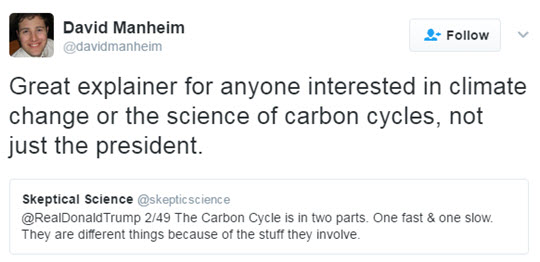
Knowing Twitter to be the prefered means of communication for the current POTUS and that he “may” have a thing or two to learn about climate science, John Mason recently set out to explain the carbon cycle in a series of 49 tweets in a language we hoped Donald Trump would be able to grasp.
As John explained: “I often wonder if a lot of climate change communication follows formats that may be unattractive to some people. Lengthy posts complete with explanatory graphics are appreciated by many, but others simply may not have the time to work through them for all sorts of reasons. Yet, this should not exclude them from accessing information. So regardless of whether Trump read the tweets or not, I wanted to proceed with this as an experiment in making climate communication available to a wider demographic. The simpler the framing of information, the more quickly it may be scanned and absorbed. I picked a fairly complex aspect of planetary science - Earth’s Carbon Cycle - and set out to simplify it whilst keeping it consistent with what the science says.
So, on February 28, the tweets started to go out on Twitter in a little tweet storm:
A good two hours later the final tweets were sent:
 This little storm showed up in our Twitter stats almost immediately where it more than doubled the impressions compared to a typical day where we get around 12,000:
This little storm showed up in our Twitter stats almost immediately where it more than doubled the impressions compared to a typical day where we get around 12,000:

The peak is even more pronounced if we look at the past 28 days:

We of course don’t know if Donald Trump read - or even noticed - any of these tweets and if he did, whether he understood them. But, from some obviously not representative sample of comments we know that at least some people DID learn from this experimental blog post. Here are a few examples:
From Twitter:
 On John Mason’s Facebook page:
On John Mason’s Facebook page:
AO - Yes! I like bite size information. Even though I've got a keen interest in the topic, I often feel overwhelmed by pages long worthy articles or I simply haven't got the time to read them.
AT - Same here.
I use social media on the whole to escape the news and the mundanity of life and to av a larf like innit.
So I also tend to avoid lengthy serious articles always intending to read them later and never do.
JS - Don't recall us being compared to a dinosaur killing volcano before...good work ! A few words have too many syllables for the intended recipient...but the language and tone is awesome :-) :-) :-) sharing with a few youngstars' teachers...maybe it will be more appealing than the usual offerings.
CD - Brilliant broken down like that for climate ignoramuses like me and Trumpton...though the comments from the must correct brigade left me cold nit picking over details...the fact that mans contribution to the destruction of our planet = a catastrophic planet destroying volcanic eruption was a visual image even I, a science idiot understood! I think Trump would have lost interest by the time the real info started to be explained though....he has the attention span of a squashed gnat by all accounts…
What about limestone?
The blog post hadn't been online for long, when a little discussion about some details regarding limestone (tweet2 23 & 24) did perhaps miss the point of the post and the tweets a little bit:
“23 & 24 so WRONG! Calcification a SOURCE not sink of CO2. See Equation 1 of OA not OK (link left side bar). COMPLEX - some buts and ifs.”
John Mason provided an explanation:
“In terms of total carbon though (which is the subject here), half the carbon from bicarbonate swishing around in the sea gets locked away as calcium carbonate. Hence the specific description of limestone as a CARBON sink, not a CO2 sink. Every description of the slow carbon cycle mentions the same. Carbon locked up in limestone is mostly out of the way, unless it gets cooked or weathered - and for a lot of limestone that's only a minor, localised process.”
John also notes: “according to the IPCC, the glossary definition of a "sink" is:
Any process, activity or mechanism that removes a greenhouse gas (GHG), an aerosol or a precursor of a GHG or aerosol from the atmosphere. {WGI, II, III}
The overall equation of the process of basalt weathering and carbonate precipitation is often expressed as follows:
CO2 + CaSiO3 = CaCO3 + SiO2
That satisfies the IPCC definition - even if integral parts of what is a multi-stage process do not! However the same definition is satisfied by photosynthesis, even though it is seasonal in nature and balanced out by other parts of the fast carbon cycle that return biogenic CO2 to the atmosphere.
However, it is important that people understand that limestone stores vast amounts of carbon out of harm’s way. Perhaps a more Trumpish description of limestone would be a carbon TRAP. Stuck right in there. Loser.
This "limestone issue" also made it into a tweet:
Such teething troubles are in any case to be expected when attempting to distill complex processes into simple words and we intend to continue with this interesting experiment. We’ll be exploring some other aspects of the Earth-Sun-climate system, using the same format, in the coming weeks and any constructive feedback is very much appreciated.
Posted by BaerbelW on Wednesday, 8 March, 2017
 |
The Skeptical Science website by Skeptical Science is licensed under a Creative Commons Attribution 3.0 Unported License. |